Business and the Business Environment Report for M&S
VerifiedAdded on 2020/07/23
|20
|5040
|477
Report
AI Summary
This report analyzes the business environment of Marks and Spencer (M&S), a UK-based retail organization. It begins by differentiating between public, private, and voluntary sector organizations, detailing their purposes, legal structures, sizes, and scopes, with a focus on M&S. The report then explores the interrelations of functional departments within M&S, such as finance, marketing, production, and HR, and their impact on organizational objectives, while also examining the influence of organizational structures. Furthermore, it delves into the positive and negative impacts of the macro-environment, employing PESTLE and SWOT analyses to evaluate their effects on M&S's business operations and decision-making. The analysis considers factors like political, economic, social, technological, legal, and environmental influences, concluding with an assessment of how these elements shape M&S's strategic approach and performance.
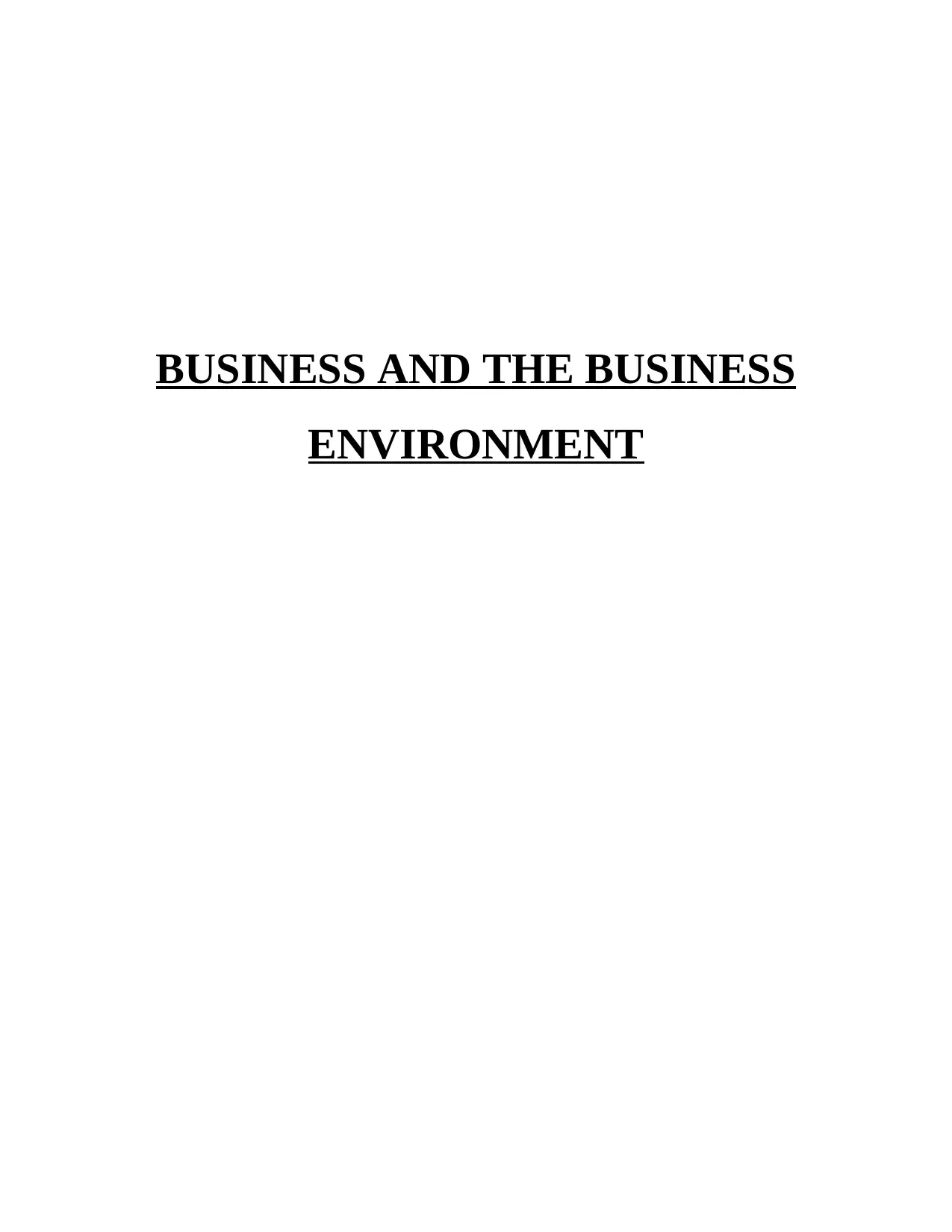
BUSINESS AND THE BUSINESS
ENVIRONMENT
ENVIRONMENT
Paraphrase This Document
Need a fresh take? Get an instant paraphrase of this document with our AI Paraphraser
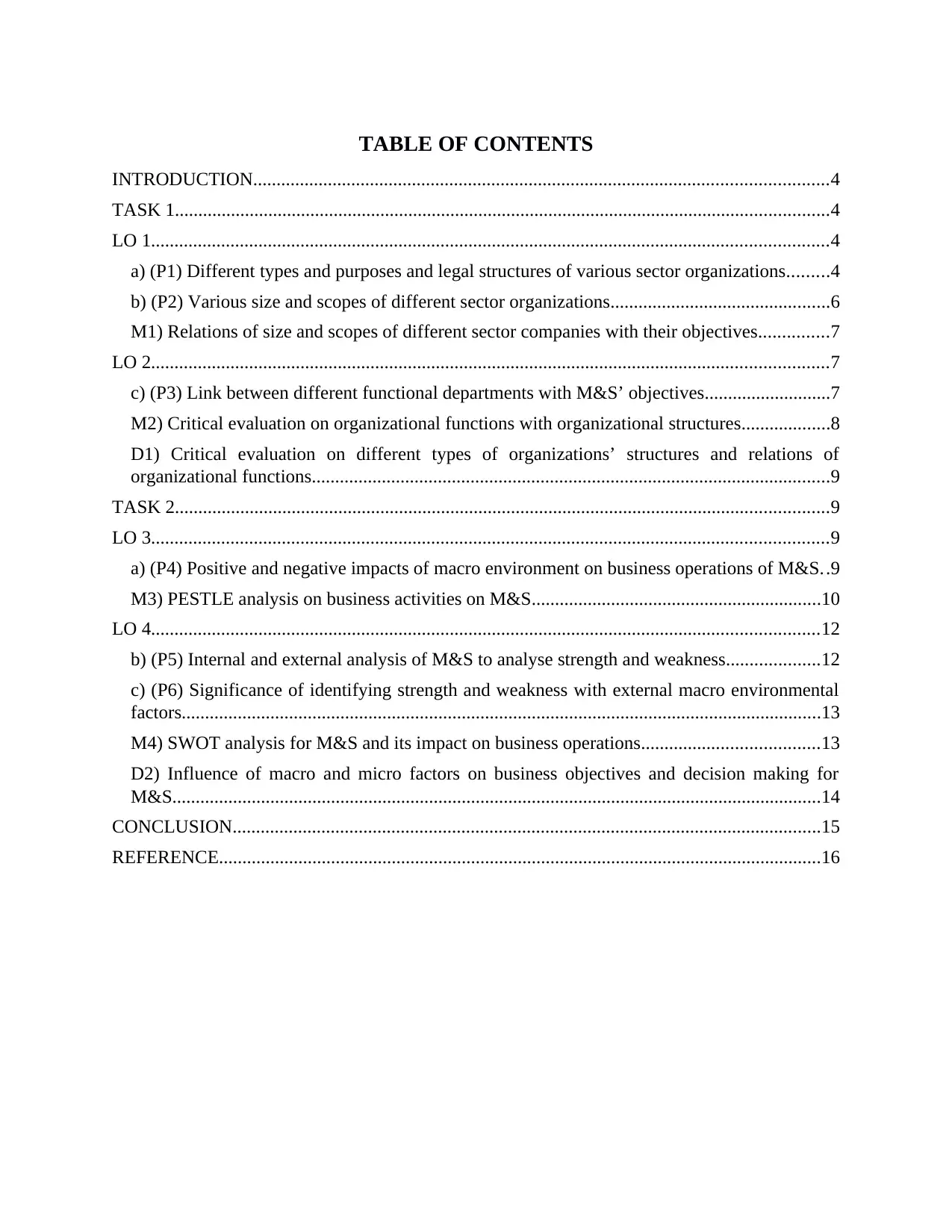
TABLE OF CONTENTS
INTRODUCTION...........................................................................................................................4
TASK 1............................................................................................................................................4
LO 1.................................................................................................................................................4
a) (P1) Different types and purposes and legal structures of various sector organizations.........4
b) (P2) Various size and scopes of different sector organizations...............................................6
M1) Relations of size and scopes of different sector companies with their objectives...............7
LO 2.................................................................................................................................................7
c) (P3) Link between different functional departments with M&S’ objectives...........................7
M2) Critical evaluation on organizational functions with organizational structures...................8
D1) Critical evaluation on different types of organizations’ structures and relations of
organizational functions...............................................................................................................9
TASK 2............................................................................................................................................9
LO 3.................................................................................................................................................9
a) (P4) Positive and negative impacts of macro environment on business operations of M&S..9
M3) PESTLE analysis on business activities on M&S..............................................................10
LO 4...............................................................................................................................................12
b) (P5) Internal and external analysis of M&S to analyse strength and weakness....................12
c) (P6) Significance of identifying strength and weakness with external macro environmental
factors.........................................................................................................................................13
M4) SWOT analysis for M&S and its impact on business operations......................................13
D2) Influence of macro and micro factors on business objectives and decision making for
M&S...........................................................................................................................................14
CONCLUSION..............................................................................................................................15
REFERENCE.................................................................................................................................16
INTRODUCTION...........................................................................................................................4
TASK 1............................................................................................................................................4
LO 1.................................................................................................................................................4
a) (P1) Different types and purposes and legal structures of various sector organizations.........4
b) (P2) Various size and scopes of different sector organizations...............................................6
M1) Relations of size and scopes of different sector companies with their objectives...............7
LO 2.................................................................................................................................................7
c) (P3) Link between different functional departments with M&S’ objectives...........................7
M2) Critical evaluation on organizational functions with organizational structures...................8
D1) Critical evaluation on different types of organizations’ structures and relations of
organizational functions...............................................................................................................9
TASK 2............................................................................................................................................9
LO 3.................................................................................................................................................9
a) (P4) Positive and negative impacts of macro environment on business operations of M&S..9
M3) PESTLE analysis on business activities on M&S..............................................................10
LO 4...............................................................................................................................................12
b) (P5) Internal and external analysis of M&S to analyse strength and weakness....................12
c) (P6) Significance of identifying strength and weakness with external macro environmental
factors.........................................................................................................................................13
M4) SWOT analysis for M&S and its impact on business operations......................................13
D2) Influence of macro and micro factors on business objectives and decision making for
M&S...........................................................................................................................................14
CONCLUSION..............................................................................................................................15
REFERENCE.................................................................................................................................16

⊘ This is a preview!⊘
Do you want full access?
Subscribe today to unlock all pages.

Trusted by 1+ million students worldwide

Paraphrase This Document
Need a fresh take? Get an instant paraphrase of this document with our AI Paraphraser
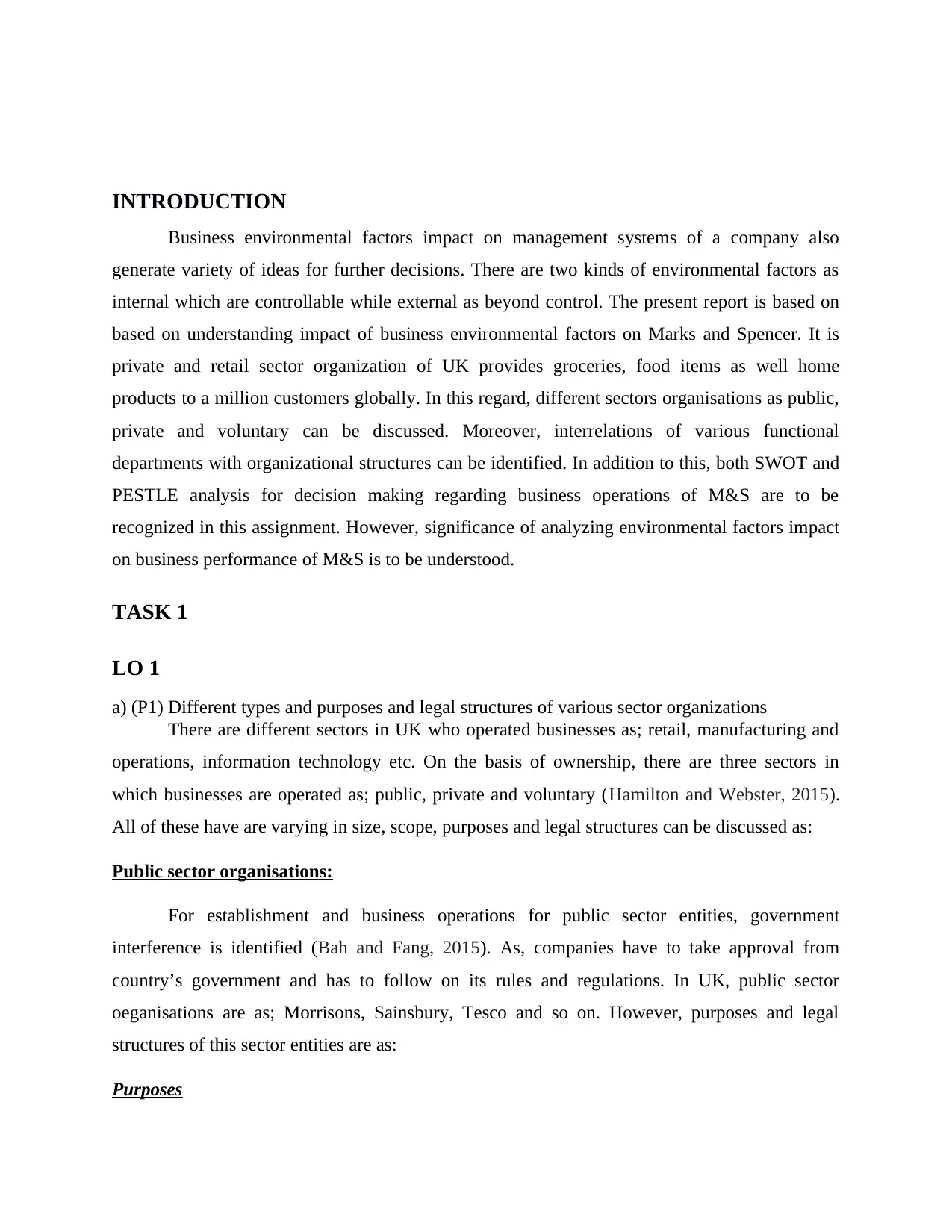
INTRODUCTION
Business environmental factors impact on management systems of a company also
generate variety of ideas for further decisions. There are two kinds of environmental factors as
internal which are controllable while external as beyond control. The present report is based on
based on understanding impact of business environmental factors on Marks and Spencer. It is
private and retail sector organization of UK provides groceries, food items as well home
products to a million customers globally. In this regard, different sectors organisations as public,
private and voluntary can be discussed. Moreover, interrelations of various functional
departments with organizational structures can be identified. In addition to this, both SWOT and
PESTLE analysis for decision making regarding business operations of M&S are to be
recognized in this assignment. However, significance of analyzing environmental factors impact
on business performance of M&S is to be understood.
TASK 1
LO 1
a) (P1) Different types and purposes and legal structures of various sector organizations
There are different sectors in UK who operated businesses as; retail, manufacturing and
operations, information technology etc. On the basis of ownership, there are three sectors in
which businesses are operated as; public, private and voluntary (Hamilton and Webster, 2015).
All of these have are varying in size, scope, purposes and legal structures can be discussed as:
Public sector organisations:
For establishment and business operations for public sector entities, government
interference is identified (Bah and Fang, 2015). As, companies have to take approval from
country’s government and has to follow on its rules and regulations. In UK, public sector
oeganisations are as; Morrisons, Sainsbury, Tesco and so on. However, purposes and legal
structures of this sector entities are as:
Purposes
Business environmental factors impact on management systems of a company also
generate variety of ideas for further decisions. There are two kinds of environmental factors as
internal which are controllable while external as beyond control. The present report is based on
based on understanding impact of business environmental factors on Marks and Spencer. It is
private and retail sector organization of UK provides groceries, food items as well home
products to a million customers globally. In this regard, different sectors organisations as public,
private and voluntary can be discussed. Moreover, interrelations of various functional
departments with organizational structures can be identified. In addition to this, both SWOT and
PESTLE analysis for decision making regarding business operations of M&S are to be
recognized in this assignment. However, significance of analyzing environmental factors impact
on business performance of M&S is to be understood.
TASK 1
LO 1
a) (P1) Different types and purposes and legal structures of various sector organizations
There are different sectors in UK who operated businesses as; retail, manufacturing and
operations, information technology etc. On the basis of ownership, there are three sectors in
which businesses are operated as; public, private and voluntary (Hamilton and Webster, 2015).
All of these have are varying in size, scope, purposes and legal structures can be discussed as:
Public sector organisations:
For establishment and business operations for public sector entities, government
interference is identified (Bah and Fang, 2015). As, companies have to take approval from
country’s government and has to follow on its rules and regulations. In UK, public sector
oeganisations are as; Morrisons, Sainsbury, Tesco and so on. However, purposes and legal
structures of this sector entities are as:
Purposes
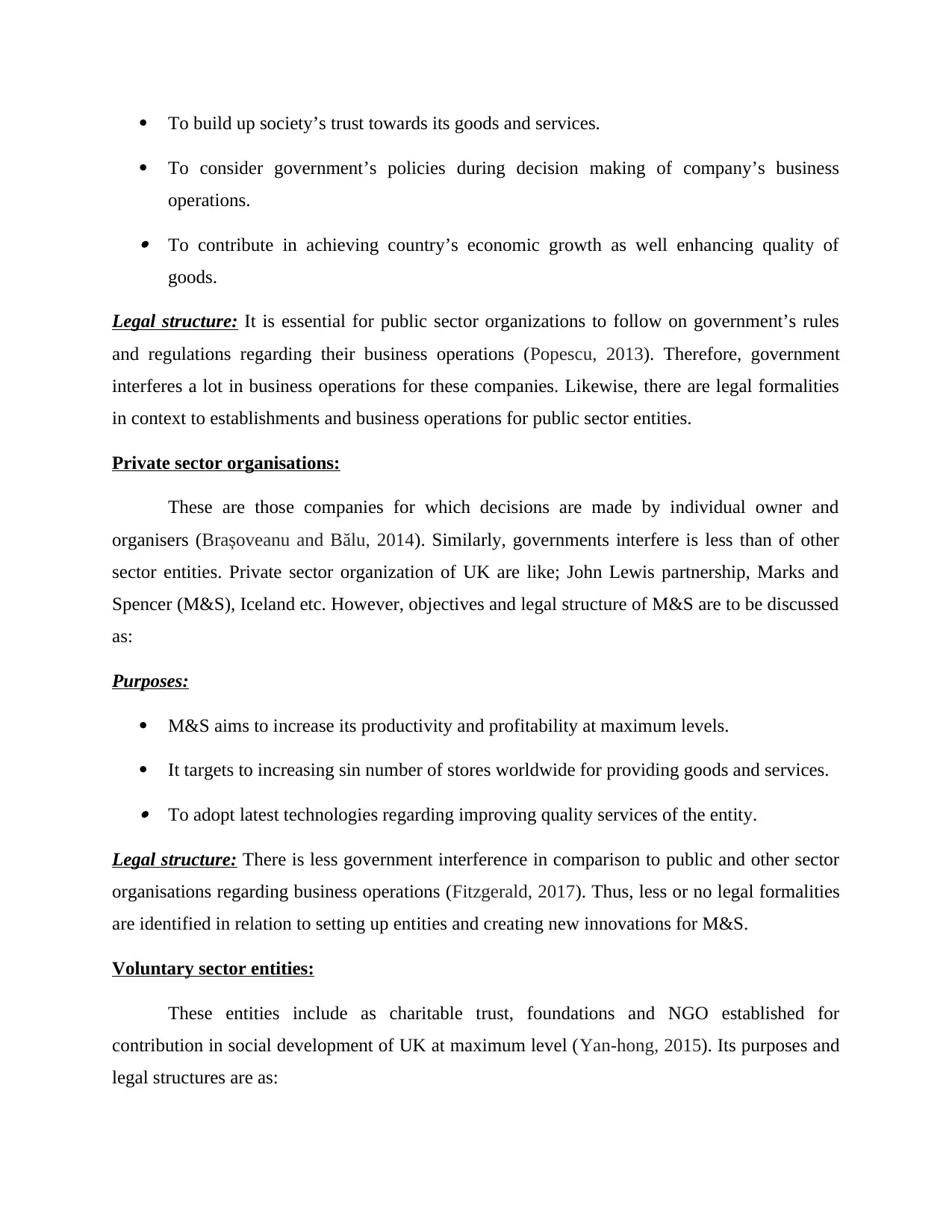
To build up society’s trust towards its goods and services.
To consider government’s policies during decision making of company’s business
operations. To contribute in achieving country’s economic growth as well enhancing quality of
goods.
Legal structure: It is essential for public sector organizations to follow on government’s rules
and regulations regarding their business operations (Popescu, 2013). Therefore, government
interferes a lot in business operations for these companies. Likewise, there are legal formalities
in context to establishments and business operations for public sector entities.
Private sector organisations:
These are those companies for which decisions are made by individual owner and
organisers (Brașoveanu and Bălu, 2014). Similarly, governments interfere is less than of other
sector entities. Private sector organization of UK are like; John Lewis partnership, Marks and
Spencer (M&S), Iceland etc. However, objectives and legal structure of M&S are to be discussed
as:
Purposes:
M&S aims to increase its productivity and profitability at maximum levels.
It targets to increasing sin number of stores worldwide for providing goods and services. To adopt latest technologies regarding improving quality services of the entity.
Legal structure: There is less government interference in comparison to public and other sector
organisations regarding business operations (Fitzgerald, 2017). Thus, less or no legal formalities
are identified in relation to setting up entities and creating new innovations for M&S.
Voluntary sector entities:
These entities include as charitable trust, foundations and NGO established for
contribution in social development of UK at maximum level (Yan-hong, 2015). Its purposes and
legal structures are as:
To consider government’s policies during decision making of company’s business
operations. To contribute in achieving country’s economic growth as well enhancing quality of
goods.
Legal structure: It is essential for public sector organizations to follow on government’s rules
and regulations regarding their business operations (Popescu, 2013). Therefore, government
interferes a lot in business operations for these companies. Likewise, there are legal formalities
in context to establishments and business operations for public sector entities.
Private sector organisations:
These are those companies for which decisions are made by individual owner and
organisers (Brașoveanu and Bălu, 2014). Similarly, governments interfere is less than of other
sector entities. Private sector organization of UK are like; John Lewis partnership, Marks and
Spencer (M&S), Iceland etc. However, objectives and legal structure of M&S are to be discussed
as:
Purposes:
M&S aims to increase its productivity and profitability at maximum levels.
It targets to increasing sin number of stores worldwide for providing goods and services. To adopt latest technologies regarding improving quality services of the entity.
Legal structure: There is less government interference in comparison to public and other sector
organisations regarding business operations (Fitzgerald, 2017). Thus, less or no legal formalities
are identified in relation to setting up entities and creating new innovations for M&S.
Voluntary sector entities:
These entities include as charitable trust, foundations and NGO established for
contribution in social development of UK at maximum level (Yan-hong, 2015). Its purposes and
legal structures are as:
⊘ This is a preview!⊘
Do you want full access?
Subscribe today to unlock all pages.

Trusted by 1+ million students worldwide
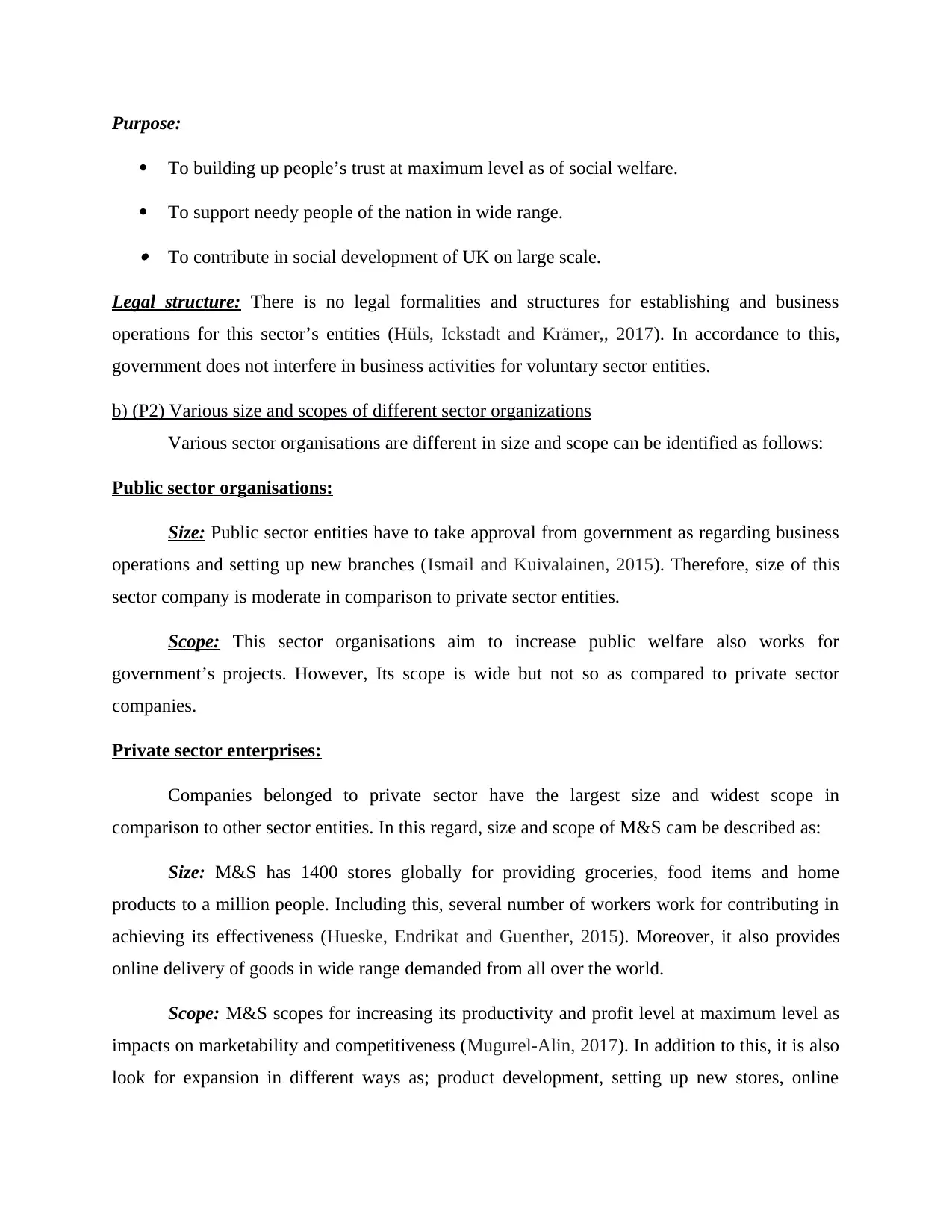
Purpose:
To building up people’s trust at maximum level as of social welfare.
To support needy people of the nation in wide range. To contribute in social development of UK on large scale.
Legal structure: There is no legal formalities and structures for establishing and business
operations for this sector’s entities (Hüls, Ickstadt and Krämer,, 2017). In accordance to this,
government does not interfere in business activities for voluntary sector entities.
b) (P2) Various size and scopes of different sector organizations
Various sector organisations are different in size and scope can be identified as follows:
Public sector organisations:
Size: Public sector entities have to take approval from government as regarding business
operations and setting up new branches (Ismail and Kuivalainen, 2015). Therefore, size of this
sector company is moderate in comparison to private sector entities.
Scope: This sector organisations aim to increase public welfare also works for
government’s projects. However, Its scope is wide but not so as compared to private sector
companies.
Private sector enterprises:
Companies belonged to private sector have the largest size and widest scope in
comparison to other sector entities. In this regard, size and scope of M&S cam be described as:
Size: M&S has 1400 stores globally for providing groceries, food items and home
products to a million people. Including this, several number of workers work for contributing in
achieving its effectiveness (Hueske, Endrikat and Guenther, 2015). Moreover, it also provides
online delivery of goods in wide range demanded from all over the world.
Scope: M&S scopes for increasing its productivity and profit level at maximum level as
impacts on marketability and competitiveness (Mugurel-Alin, 2017). In addition to this, it is also
look for expansion in different ways as; product development, setting up new stores, online
To building up people’s trust at maximum level as of social welfare.
To support needy people of the nation in wide range. To contribute in social development of UK on large scale.
Legal structure: There is no legal formalities and structures for establishing and business
operations for this sector’s entities (Hüls, Ickstadt and Krämer,, 2017). In accordance to this,
government does not interfere in business activities for voluntary sector entities.
b) (P2) Various size and scopes of different sector organizations
Various sector organisations are different in size and scope can be identified as follows:
Public sector organisations:
Size: Public sector entities have to take approval from government as regarding business
operations and setting up new branches (Ismail and Kuivalainen, 2015). Therefore, size of this
sector company is moderate in comparison to private sector entities.
Scope: This sector organisations aim to increase public welfare also works for
government’s projects. However, Its scope is wide but not so as compared to private sector
companies.
Private sector enterprises:
Companies belonged to private sector have the largest size and widest scope in
comparison to other sector entities. In this regard, size and scope of M&S cam be described as:
Size: M&S has 1400 stores globally for providing groceries, food items and home
products to a million people. Including this, several number of workers work for contributing in
achieving its effectiveness (Hueske, Endrikat and Guenther, 2015). Moreover, it also provides
online delivery of goods in wide range demanded from all over the world.
Scope: M&S scopes for increasing its productivity and profit level at maximum level as
impacts on marketability and competitiveness (Mugurel-Alin, 2017). In addition to this, it is also
look for expansion in different ways as; product development, setting up new stores, online
Paraphrase This Document
Need a fresh take? Get an instant paraphrase of this document with our AI Paraphraser
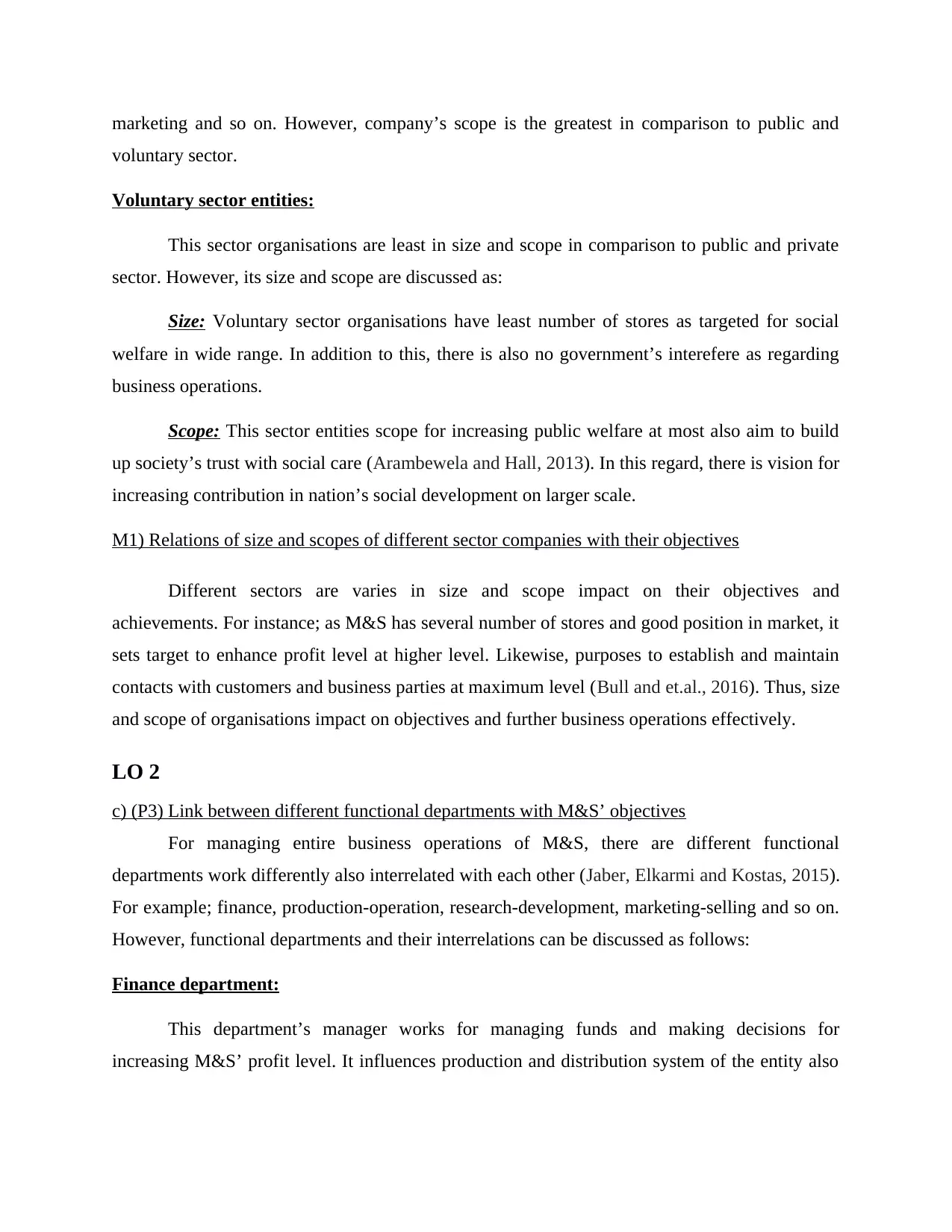
marketing and so on. However, company’s scope is the greatest in comparison to public and
voluntary sector.
Voluntary sector entities:
This sector organisations are least in size and scope in comparison to public and private
sector. However, its size and scope are discussed as:
Size: Voluntary sector organisations have least number of stores as targeted for social
welfare in wide range. In addition to this, there is also no government’s interefere as regarding
business operations.
Scope: This sector entities scope for increasing public welfare at most also aim to build
up society’s trust with social care (Arambewela and Hall, 2013). In this regard, there is vision for
increasing contribution in nation’s social development on larger scale.
M1) Relations of size and scopes of different sector companies with their objectives
Different sectors are varies in size and scope impact on their objectives and
achievements. For instance; as M&S has several number of stores and good position in market, it
sets target to enhance profit level at higher level. Likewise, purposes to establish and maintain
contacts with customers and business parties at maximum level (Bull and et.al., 2016). Thus, size
and scope of organisations impact on objectives and further business operations effectively.
LO 2
c) (P3) Link between different functional departments with M&S’ objectives
For managing entire business operations of M&S, there are different functional
departments work differently also interrelated with each other (Jaber, Elkarmi and Kostas, 2015).
For example; finance, production-operation, research-development, marketing-selling and so on.
However, functional departments and their interrelations can be discussed as follows:
Finance department:
This department’s manager works for managing funds and making decisions for
increasing M&S’ profit level. It influences production and distribution system of the entity also
voluntary sector.
Voluntary sector entities:
This sector organisations are least in size and scope in comparison to public and private
sector. However, its size and scope are discussed as:
Size: Voluntary sector organisations have least number of stores as targeted for social
welfare in wide range. In addition to this, there is also no government’s interefere as regarding
business operations.
Scope: This sector entities scope for increasing public welfare at most also aim to build
up society’s trust with social care (Arambewela and Hall, 2013). In this regard, there is vision for
increasing contribution in nation’s social development on larger scale.
M1) Relations of size and scopes of different sector companies with their objectives
Different sectors are varies in size and scope impact on their objectives and
achievements. For instance; as M&S has several number of stores and good position in market, it
sets target to enhance profit level at higher level. Likewise, purposes to establish and maintain
contacts with customers and business parties at maximum level (Bull and et.al., 2016). Thus, size
and scope of organisations impact on objectives and further business operations effectively.
LO 2
c) (P3) Link between different functional departments with M&S’ objectives
For managing entire business operations of M&S, there are different functional
departments work differently also interrelated with each other (Jaber, Elkarmi and Kostas, 2015).
For example; finance, production-operation, research-development, marketing-selling and so on.
However, functional departments and their interrelations can be discussed as follows:
Finance department:
This department’s manager works for managing funds and making decisions for
increasing M&S’ profit level. It influences production and distribution system of the entity also
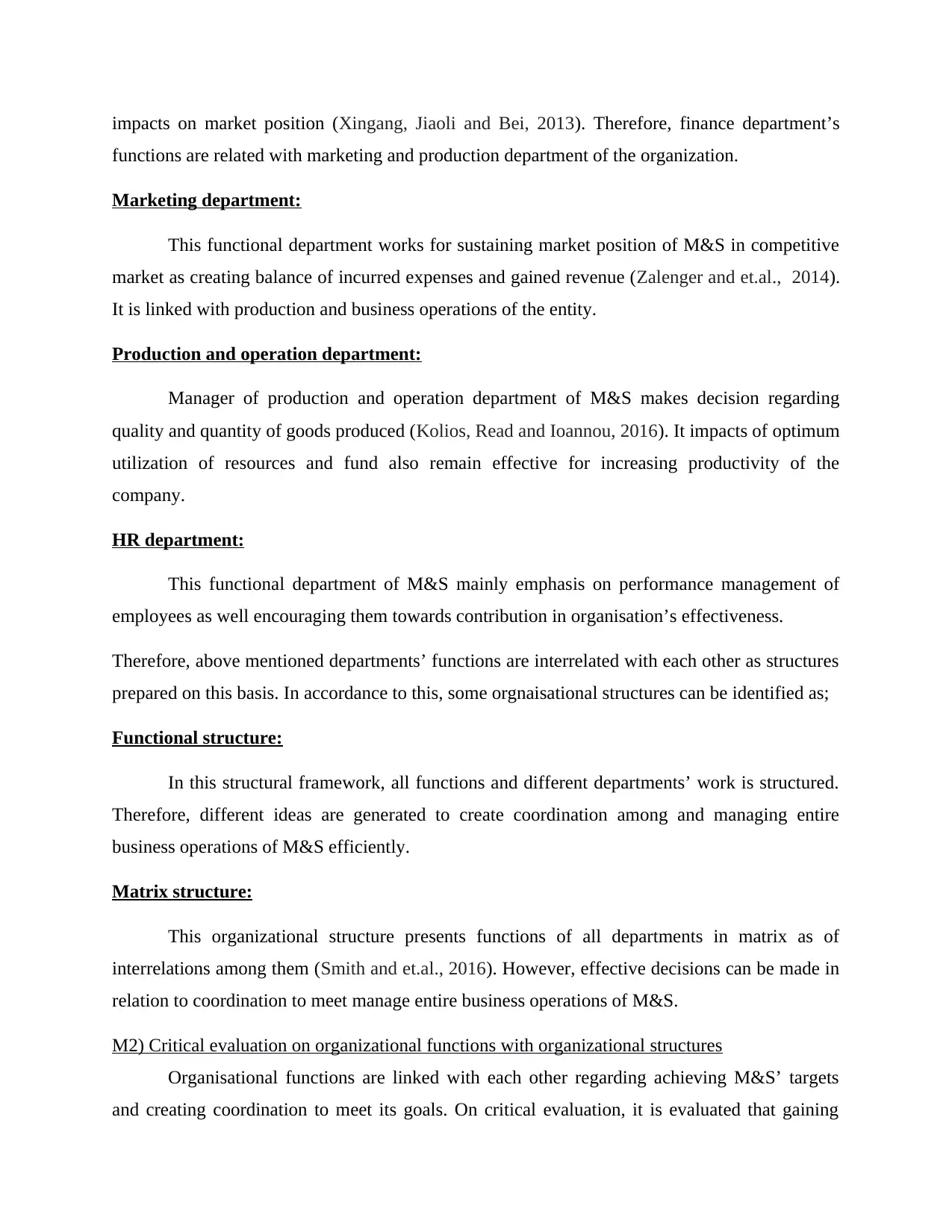
impacts on market position (Xingang, Jiaoli and Bei, 2013). Therefore, finance department’s
functions are related with marketing and production department of the organization.
Marketing department:
This functional department works for sustaining market position of M&S in competitive
market as creating balance of incurred expenses and gained revenue (Zalenger and et.al., 2014).
It is linked with production and business operations of the entity.
Production and operation department:
Manager of production and operation department of M&S makes decision regarding
quality and quantity of goods produced (Kolios, Read and Ioannou, 2016). It impacts of optimum
utilization of resources and fund also remain effective for increasing productivity of the
company.
HR department:
This functional department of M&S mainly emphasis on performance management of
employees as well encouraging them towards contribution in organisation’s effectiveness.
Therefore, above mentioned departments’ functions are interrelated with each other as structures
prepared on this basis. In accordance to this, some orgnaisational structures can be identified as;
Functional structure:
In this structural framework, all functions and different departments’ work is structured.
Therefore, different ideas are generated to create coordination among and managing entire
business operations of M&S efficiently.
Matrix structure:
This organizational structure presents functions of all departments in matrix as of
interrelations among them (Smith and et.al., 2016). However, effective decisions can be made in
relation to coordination to meet manage entire business operations of M&S.
M2) Critical evaluation on organizational functions with organizational structures
Organisational functions are linked with each other regarding achieving M&S’ targets
and creating coordination to meet its goals. On critical evaluation, it is evaluated that gaining
functions are related with marketing and production department of the organization.
Marketing department:
This functional department works for sustaining market position of M&S in competitive
market as creating balance of incurred expenses and gained revenue (Zalenger and et.al., 2014).
It is linked with production and business operations of the entity.
Production and operation department:
Manager of production and operation department of M&S makes decision regarding
quality and quantity of goods produced (Kolios, Read and Ioannou, 2016). It impacts of optimum
utilization of resources and fund also remain effective for increasing productivity of the
company.
HR department:
This functional department of M&S mainly emphasis on performance management of
employees as well encouraging them towards contribution in organisation’s effectiveness.
Therefore, above mentioned departments’ functions are interrelated with each other as structures
prepared on this basis. In accordance to this, some orgnaisational structures can be identified as;
Functional structure:
In this structural framework, all functions and different departments’ work is structured.
Therefore, different ideas are generated to create coordination among and managing entire
business operations of M&S efficiently.
Matrix structure:
This organizational structure presents functions of all departments in matrix as of
interrelations among them (Smith and et.al., 2016). However, effective decisions can be made in
relation to coordination to meet manage entire business operations of M&S.
M2) Critical evaluation on organizational functions with organizational structures
Organisational functions are linked with each other regarding achieving M&S’ targets
and creating coordination to meet its goals. On critical evaluation, it is evaluated that gaining
⊘ This is a preview!⊘
Do you want full access?
Subscribe today to unlock all pages.

Trusted by 1+ million students worldwide
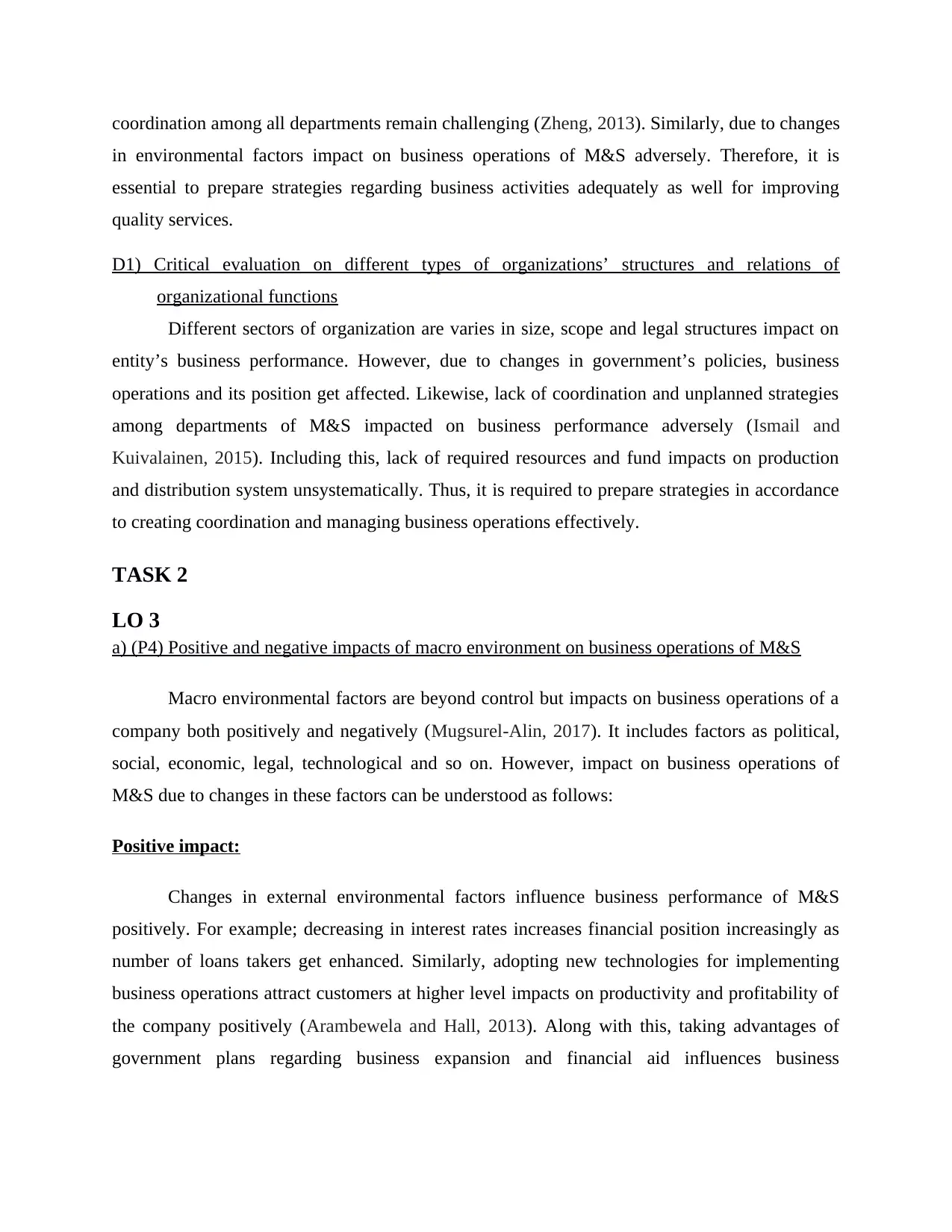
coordination among all departments remain challenging (Zheng, 2013). Similarly, due to changes
in environmental factors impact on business operations of M&S adversely. Therefore, it is
essential to prepare strategies regarding business activities adequately as well for improving
quality services.
D1) Critical evaluation on different types of organizations’ structures and relations of
organizational functions
Different sectors of organization are varies in size, scope and legal structures impact on
entity’s business performance. However, due to changes in government’s policies, business
operations and its position get affected. Likewise, lack of coordination and unplanned strategies
among departments of M&S impacted on business performance adversely (Ismail and
Kuivalainen, 2015). Including this, lack of required resources and fund impacts on production
and distribution system unsystematically. Thus, it is required to prepare strategies in accordance
to creating coordination and managing business operations effectively.
TASK 2
LO 3
a) (P4) Positive and negative impacts of macro environment on business operations of M&S
Macro environmental factors are beyond control but impacts on business operations of a
company both positively and negatively (Mugsurel-Alin, 2017). It includes factors as political,
social, economic, legal, technological and so on. However, impact on business operations of
M&S due to changes in these factors can be understood as follows:
Positive impact:
Changes in external environmental factors influence business performance of M&S
positively. For example; decreasing in interest rates increases financial position increasingly as
number of loans takers get enhanced. Similarly, adopting new technologies for implementing
business operations attract customers at higher level impacts on productivity and profitability of
the company positively (Arambewela and Hall, 2013). Along with this, taking advantages of
government plans regarding business expansion and financial aid influences business
in environmental factors impact on business operations of M&S adversely. Therefore, it is
essential to prepare strategies regarding business activities adequately as well for improving
quality services.
D1) Critical evaluation on different types of organizations’ structures and relations of
organizational functions
Different sectors of organization are varies in size, scope and legal structures impact on
entity’s business performance. However, due to changes in government’s policies, business
operations and its position get affected. Likewise, lack of coordination and unplanned strategies
among departments of M&S impacted on business performance adversely (Ismail and
Kuivalainen, 2015). Including this, lack of required resources and fund impacts on production
and distribution system unsystematically. Thus, it is required to prepare strategies in accordance
to creating coordination and managing business operations effectively.
TASK 2
LO 3
a) (P4) Positive and negative impacts of macro environment on business operations of M&S
Macro environmental factors are beyond control but impacts on business operations of a
company both positively and negatively (Mugsurel-Alin, 2017). It includes factors as political,
social, economic, legal, technological and so on. However, impact on business operations of
M&S due to changes in these factors can be understood as follows:
Positive impact:
Changes in external environmental factors influence business performance of M&S
positively. For example; decreasing in interest rates increases financial position increasingly as
number of loans takers get enhanced. Similarly, adopting new technologies for implementing
business operations attract customers at higher level impacts on productivity and profitability of
the company positively (Arambewela and Hall, 2013). Along with this, taking advantages of
government plans regarding business expansion and financial aid influences business
Paraphrase This Document
Need a fresh take? Get an instant paraphrase of this document with our AI Paraphraser
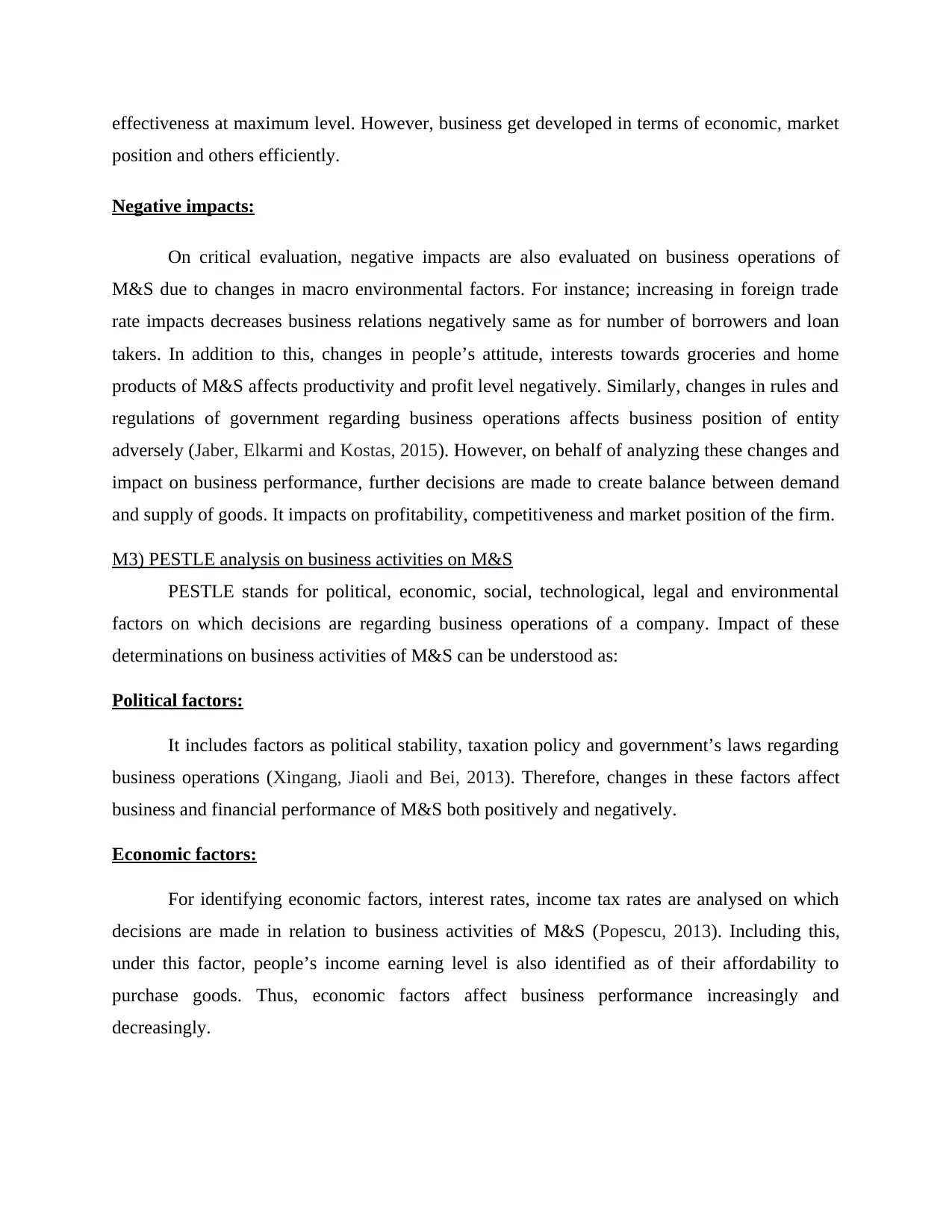
effectiveness at maximum level. However, business get developed in terms of economic, market
position and others efficiently.
Negative impacts:
On critical evaluation, negative impacts are also evaluated on business operations of
M&S due to changes in macro environmental factors. For instance; increasing in foreign trade
rate impacts decreases business relations negatively same as for number of borrowers and loan
takers. In addition to this, changes in people’s attitude, interests towards groceries and home
products of M&S affects productivity and profit level negatively. Similarly, changes in rules and
regulations of government regarding business operations affects business position of entity
adversely (Jaber, Elkarmi and Kostas, 2015). However, on behalf of analyzing these changes and
impact on business performance, further decisions are made to create balance between demand
and supply of goods. It impacts on profitability, competitiveness and market position of the firm.
M3) PESTLE analysis on business activities on M&S
PESTLE stands for political, economic, social, technological, legal and environmental
factors on which decisions are regarding business operations of a company. Impact of these
determinations on business activities of M&S can be understood as:
Political factors:
It includes factors as political stability, taxation policy and government’s laws regarding
business operations (Xingang, Jiaoli and Bei, 2013). Therefore, changes in these factors affect
business and financial performance of M&S both positively and negatively.
Economic factors:
For identifying economic factors, interest rates, income tax rates are analysed on which
decisions are made in relation to business activities of M&S (Popescu, 2013). Including this,
under this factor, people’s income earning level is also identified as of their affordability to
purchase goods. Thus, economic factors affect business performance increasingly and
decreasingly.
position and others efficiently.
Negative impacts:
On critical evaluation, negative impacts are also evaluated on business operations of
M&S due to changes in macro environmental factors. For instance; increasing in foreign trade
rate impacts decreases business relations negatively same as for number of borrowers and loan
takers. In addition to this, changes in people’s attitude, interests towards groceries and home
products of M&S affects productivity and profit level negatively. Similarly, changes in rules and
regulations of government regarding business operations affects business position of entity
adversely (Jaber, Elkarmi and Kostas, 2015). However, on behalf of analyzing these changes and
impact on business performance, further decisions are made to create balance between demand
and supply of goods. It impacts on profitability, competitiveness and market position of the firm.
M3) PESTLE analysis on business activities on M&S
PESTLE stands for political, economic, social, technological, legal and environmental
factors on which decisions are regarding business operations of a company. Impact of these
determinations on business activities of M&S can be understood as:
Political factors:
It includes factors as political stability, taxation policy and government’s laws regarding
business operations (Xingang, Jiaoli and Bei, 2013). Therefore, changes in these factors affect
business and financial performance of M&S both positively and negatively.
Economic factors:
For identifying economic factors, interest rates, income tax rates are analysed on which
decisions are made in relation to business activities of M&S (Popescu, 2013). Including this,
under this factor, people’s income earning level is also identified as of their affordability to
purchase goods. Thus, economic factors affect business performance increasingly and
decreasingly.

Social factors:
It includes analyzing factors as customers’ attitude, interest, perception is recognized in
terms of purchasing groceries and home products of M&S. Besides this, it is challenging task for
maintaining users’ interest towards company’s goods and services (Yan-hong, 2015). Moreover,
it is also impacted on profit level and competitiveness of the enterprise.
Figure 1PESTLE analysis’ factors
(Source: PESTLE environmental factors, 2016).
Technological factors:
It is considered that technologies get changes time to time which impacts on products’
quality and relations with people (Hamilton and Webster, 2015). However, investment on
purchasing new machinery equipment is challenging in respect of attracting people and
improving business performance of M&S.
Legal factors:
These factors involve as government’s rules and regulations regarding business
operations and market prices (Kolios, Read and Ioannou, 2016). Thus, dynamics in legal factors
affect business performance of M&S both positively and negatively.
Environmental factors:
These are those uncontrollable environmental factors which impact on business
operations and their management negatively (Smith and et.al., 2016). For example; occurrence of
It includes analyzing factors as customers’ attitude, interest, perception is recognized in
terms of purchasing groceries and home products of M&S. Besides this, it is challenging task for
maintaining users’ interest towards company’s goods and services (Yan-hong, 2015). Moreover,
it is also impacted on profit level and competitiveness of the enterprise.
Figure 1PESTLE analysis’ factors
(Source: PESTLE environmental factors, 2016).
Technological factors:
It is considered that technologies get changes time to time which impacts on products’
quality and relations with people (Hamilton and Webster, 2015). However, investment on
purchasing new machinery equipment is challenging in respect of attracting people and
improving business performance of M&S.
Legal factors:
These factors involve as government’s rules and regulations regarding business
operations and market prices (Kolios, Read and Ioannou, 2016). Thus, dynamics in legal factors
affect business performance of M&S both positively and negatively.
Environmental factors:
These are those uncontrollable environmental factors which impact on business
operations and their management negatively (Smith and et.al., 2016). For example; occurrence of
⊘ This is a preview!⊘
Do you want full access?
Subscribe today to unlock all pages.

Trusted by 1+ million students worldwide
1 out of 20
Related Documents
Your All-in-One AI-Powered Toolkit for Academic Success.
+13062052269
info@desklib.com
Available 24*7 on WhatsApp / Email
![[object Object]](/_next/static/media/star-bottom.7253800d.svg)
Unlock your academic potential
Copyright © 2020–2025 A2Z Services. All Rights Reserved. Developed and managed by ZUCOL.




